About a package of appreciation Information on arranging life events such as having a child, buying a house or becoming unemployed can be found on the website of the national government. However, the road to get there is too complex for the user. The goal of the project was to devise an environment in which the people who experience life events can find everything in one place and arrange things with the government. In short, devise a service. The project was carried out in a group. It was decided to focus on the target group of informal caregivers with a demented parent and look at what they should arrange around this event. The aim was to gain insights into the bottlenecks of these informal carers, to look at how they can be helped and what service the central government can offer them.
Research Various techniques have been used to find more info about the bottlenecks of these informal carers with a demented parent. First of all, qualitative interviews were carried out with people who are caregivers of their demented parent. This was done in order to gather deep information. The interview consisted of personal and practical questions. We also asked questions about going back into society. To get some extra insight, respondents were asked to fill in a timeline about events around their dement parents. This helped us discover the emotions the target group is feeling.
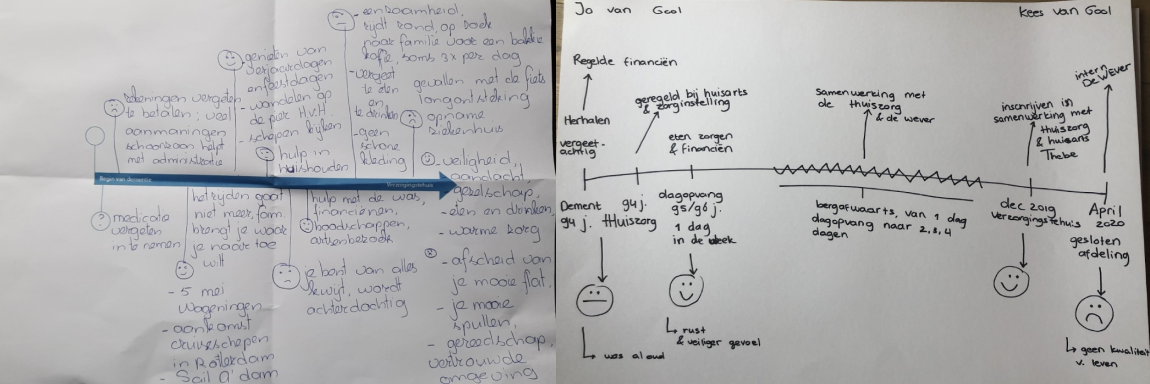
An empathy map was created in order to get a clear view of the emotions and thoughts, based on the procedure of the caregiver with their dement parent.
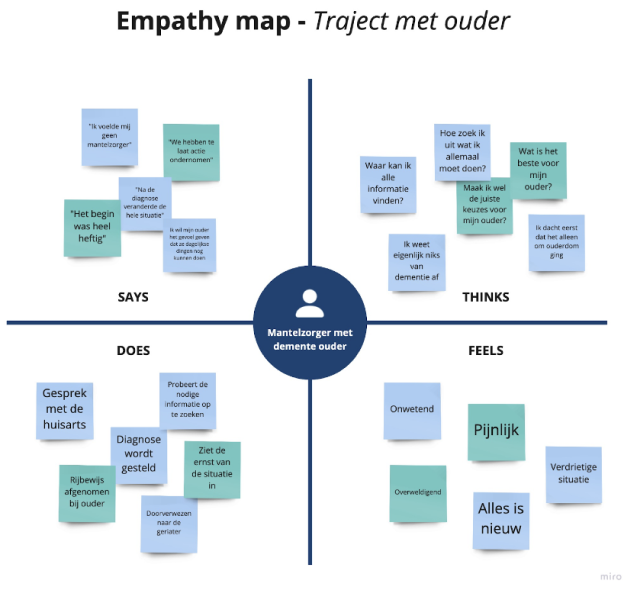
From there, we looked at the various stakeholders involved, such as the general practitioner and geriatrician.
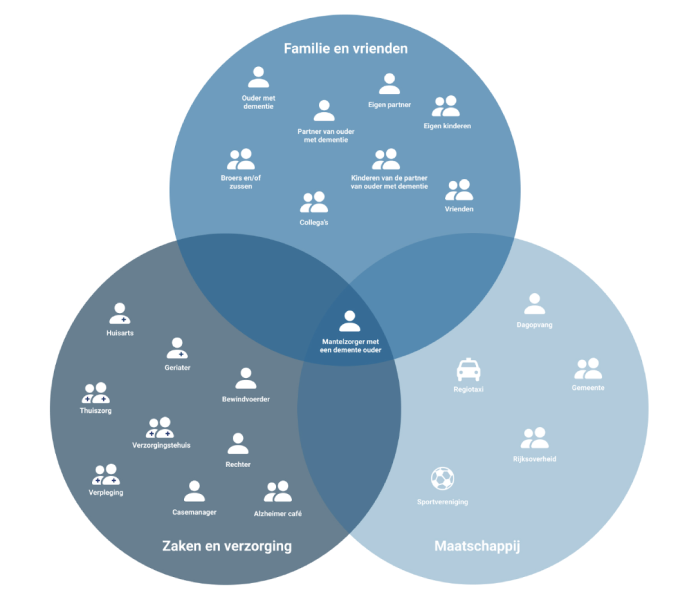
A Customer Journey Map was created to discover the problems of a caregiver. For example, we found out that the initial phase of dementia was experienced as the most difficult for caregivers. The general practitioner also played a huge role in the process for the caregiver and their parent.
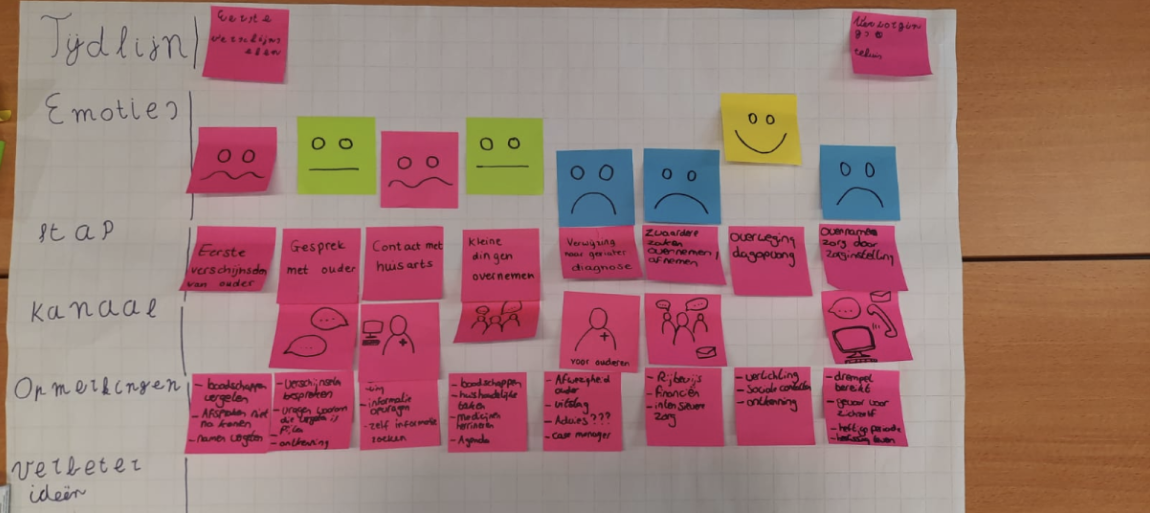
The journey map gave us new insights about the whole process and it showed when caregivers struggled the most. However, it did not show us the core problems that caregivers had in this process. This is why we made a datawall to analyse all of our insights, in order to draw more conclusions and find the biggest problems that happen in the beginning. With the help of our datawall, we managed to cluster our insights, in order to find patterns. This resulted in many discoveries why the caregivers struggle so much in the beginning of the process.
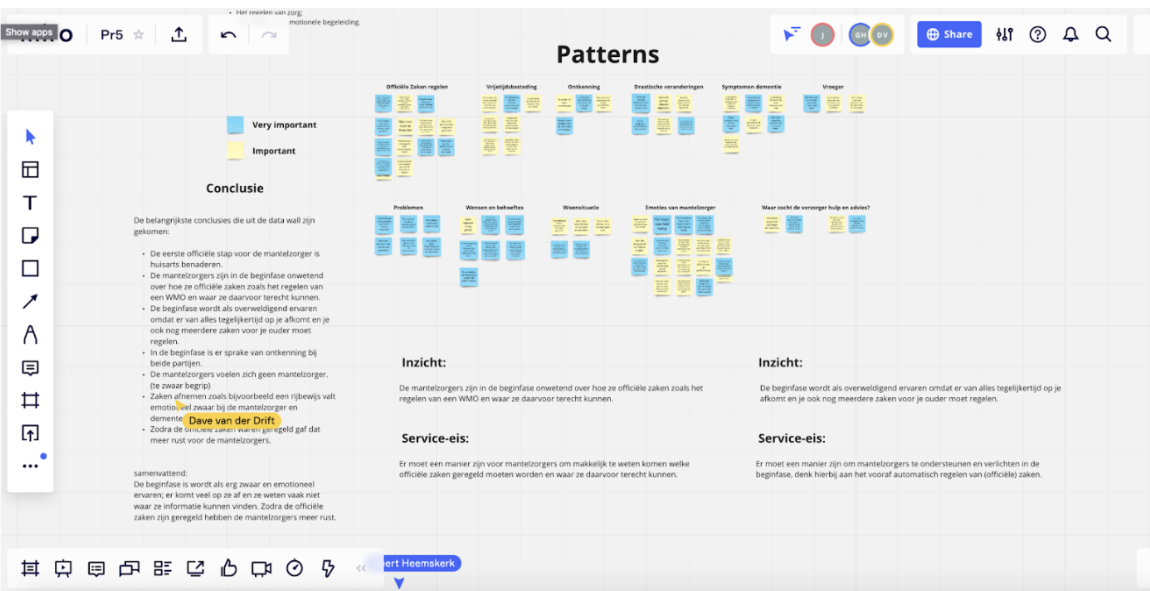
The patterns showed that the informal caregivers mainly experienced problems in the initial phase of the process, as was also apparent from the Customer Journey Map and the interviews. That is why a new Customer Journey Map has been created that focuses on the initial phase of the process.
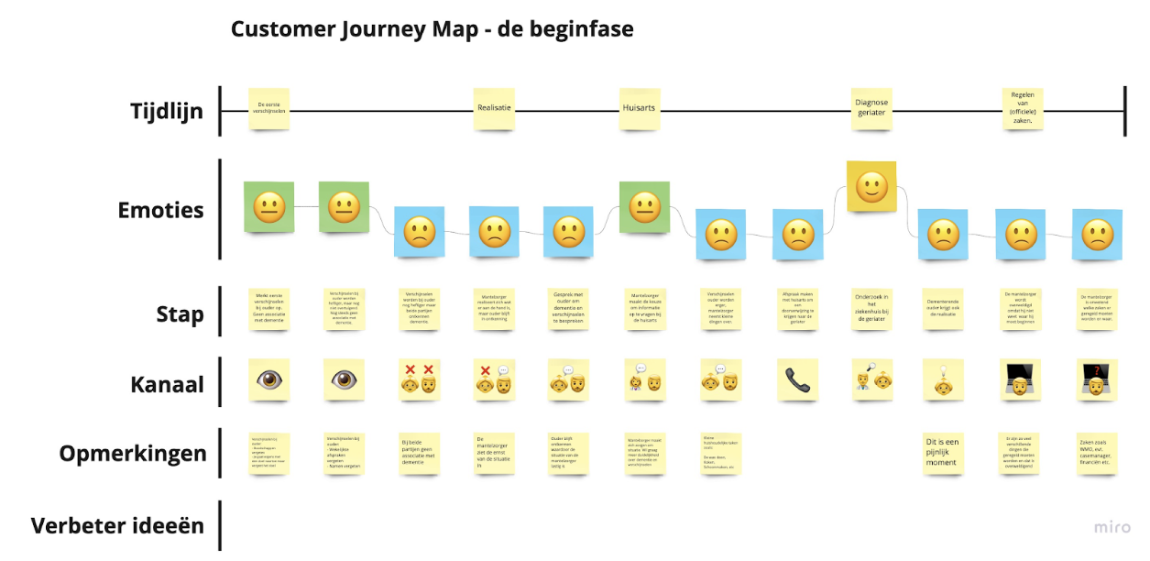
We had the idea to come up with ideas for improvement at every step of the journey map. With the ladder method, the deeper layers of the problem/key insights could be found. Subsequently, the different parts of the key insights would be positively translated into a concrete design challenge. This opens up space for new solutions. The problem, however, was that the problems were already described specifically enough and the how might we's gave repetitive ideas. So we didn't finish this and we continued with the insights from the Customer Journey Map, focusing on the initial phase.
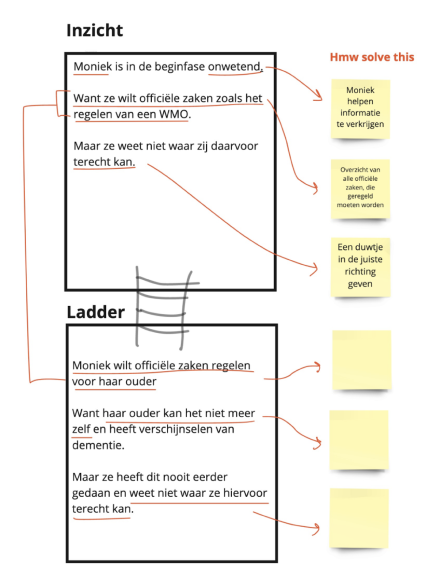
In summary, the data wall and the Customer Journey Map of the initial phase showed that the initial phase is experienced as very heavy and emotional. The caregiver has a lot to do and they often don't know where to find information. As soon as the official matters have been arranged, the informal carers have more peace of mind. In addition, they find the term 'informal carer' very heavy and as a result they often do not feel like a carer, even though they do care for their demented parent eight hours a week.
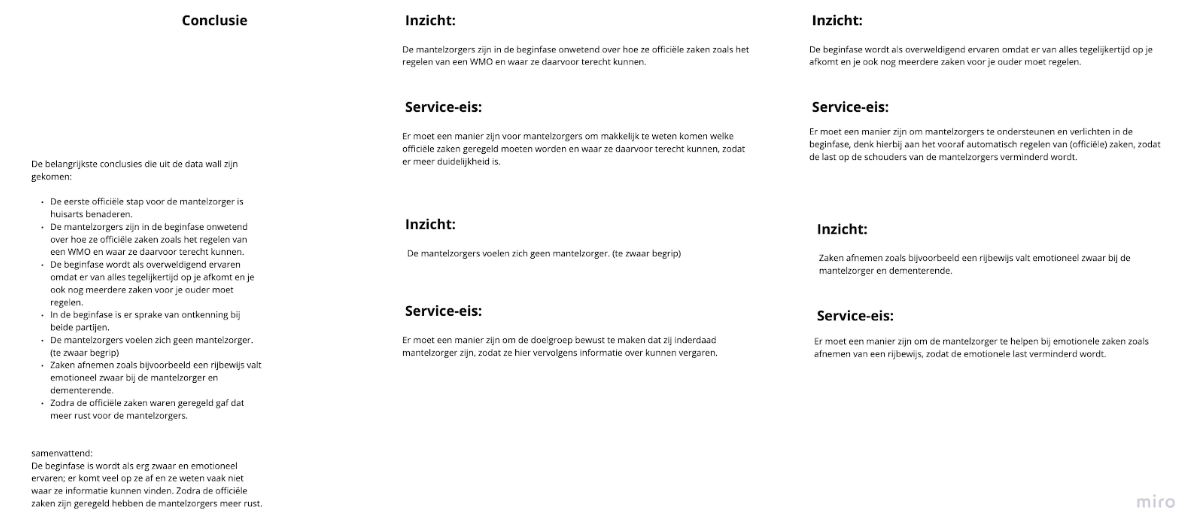
Concepts With the help of our insights that we got from our research, we started to make a mindmap. This method worked well because you can think creatively about a solution from the research problems. The interviews have resulted in multiple categories that originated from previous problems. Three categories eventually resulted into four different concepts. We eventually came to the conclusion that we could combine these concepts, resulting in two different concepts.

These two concepts had to become more concrete. Two concrete stories, explaining how the concept would work were tested with multiple caregivers. With the help of their feedback it was decided that we would go for the following concept: The carer does not feel like a carer. The central government must provide more room for appreciation towards this group. After the diagnosis, the informal caregiver receives a package at home, tailored to his/her situation as an extra on top of the information from the general practitioner/geriatrician. The package is aimed at appreciation towards the caregiver, with some extra tips and tricks. With our concept in mind, we started asking our target group what they would want inside the package. This resulted in a more personal package, based on your own situation as a caregiver with a demented parent. Our biggest challenge was what to put in the package. To solve this we made a lo-fi package, where we could write its contents on. We went step by step through all the data we had collected and found the three most important keywords: relaxation, lack of clarity, appreciation. These three keywords have been translated into the products that the package contains.
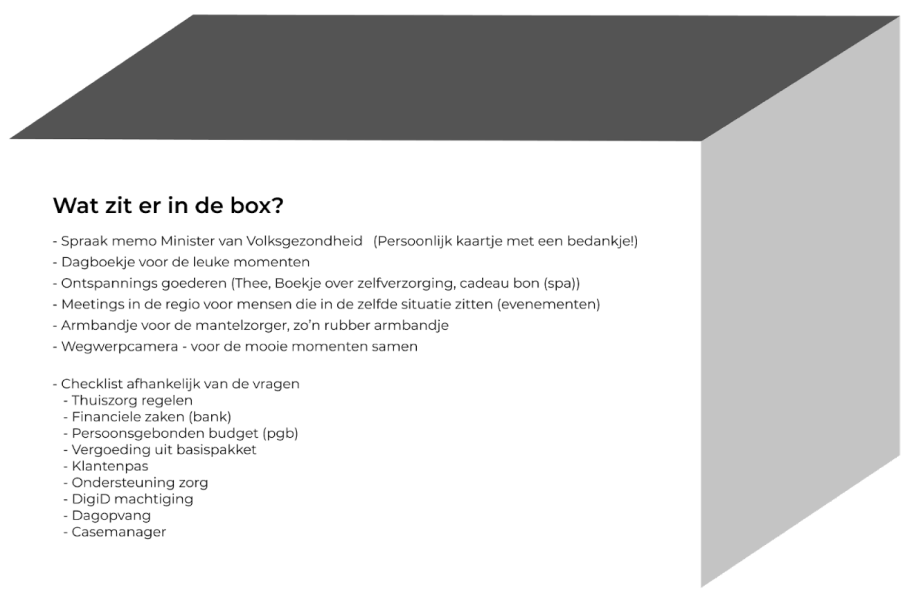
Designing the concept A style tile was made in order to give our service a strong visual identity. For example, a blue colour has been chosen because this is the exact colour of the national government, the orange/yellow colour stands for Alzheimer Netherlands and the white and black colour has been added as a basis.
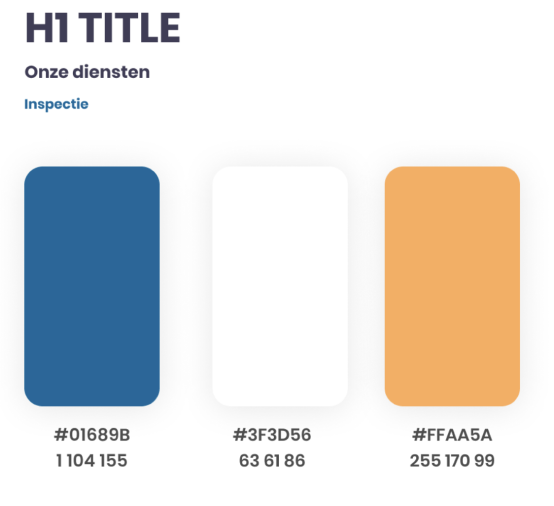
To clearly explain the concept in a nutshell, it was decided to make a poster. This contains all information about the contents of the package. To continue the style in this, we looked at previous posters of the national government. The blue colour of the central government and the orange/yellow colour of Alzheimer Nederland are also central. In order to show a clear representation of the content, it was decided to make an illustration per product. These illustrations are also in the same colours. The poster also contains an explanation of the products and the concept. A QR code has also been added that leads the user to the information page of the central government.

A storyboard was made to clarify the process of the package appreciation This visually represents the process from detecting dementia in your parent to receiving the package of appreciation. In order to indicate the same style here, it has been decided to make the illustrations in the same colours as the style tile.

Validating the concept The validation with the target group has shown that everyone is positively surprised about the service. It has been translated into a good professional product. What some feared was that it would contain too many leaflets that you can also grab from a rack. But the target group experiences it as a personal package and therefore also feels the appreciation it radiates. The target group indicates that they think it is a nice concept and that they also give them compliments.
The result After his/her parent has been diagnosed with dementia, the caregiver receives a package at home, tailored to his/her situation as an addition on top of the information from the general practitioner or geriatrician. The package is aimed at appreciation towards the informal carer. Carers also struggle to relax and have a lack of clarity. That is why there are several items in the package, namely a thank you card, a checklist with things that need to be arranged, tips for relaxing and tea, a diary, a bracelet for the caregiver and a disposable camera to capture the happy moments.